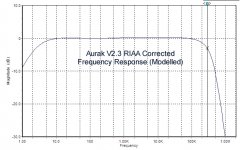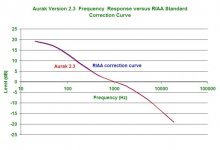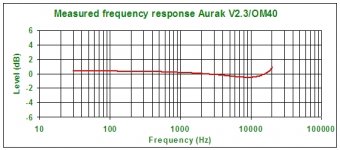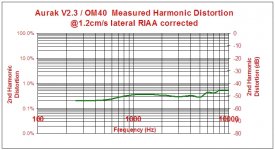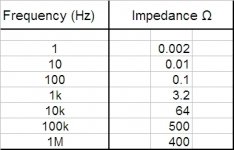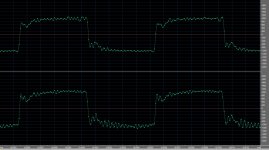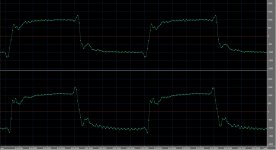Erno Borbely (remember him?) published a construction article in Linear Audio on transimpedance cartridge amplifiers. With JFETs of course:
https://linearaudio.net/volumes/787
Jan
https://linearaudio.net/volumes/787
Jan
Erno Borbely (remember him?) published a construction article in Linear Audio on transimpedance cartridge amplifiers. With JFETs of course:
https://linearaudio.net/volumes/787
Jan
Assume you are referring to this article? https://linearaudio.net/article-detail/2157
Don't we have enough to start? True transimpedance means a good false summing input to me, now just figure out the equalization right? I would start with an AD745 which is decomped and then start worrying about the inevitable oscillations. 😉
He he
True and I hear you.
I don’t think that there is another member who has designed, built and auditioned as many RIAA preamp as Joachim.
http://www.diyaudio.com/forums/analogue-source/154210-mpp-1039.html#post4202408
http://www.diyaudio.com/forums/vend...-phono-stage-paradise-team-6.html#post4860475
George
A bit of heresy if I may: Why ever play a phonograph record more than once? Play it, digitize it, and be free from any wear, clicks, pops, etc. from then on.
This is assuming, of course, that one has good enough data converters and records at high-rez.
This is assuming, of course, that one has good enough data converters and records at high-rez.
A bit of heresy if I may: Why ever play a phonograph record more than once? Play it, digitize it, and be free from any wear, clicks, pops, etc. from then on.
This is assuming, of course, that one has good enough data converters and records at high-rez.
The ritual is half the experience.
I'm shocked at how well it measures. They either lucked out or have a clever engineer or two on the staff. You can pay a lot more and get worse.Frankly I'm shocked at how nice my best kept LP's sound with my kickstarter phono setup. I gave all my "never to be finished" high-end TT projects away at a local swap fest.
I'm still collecting high end TT projects. This is probably not sensible 🙂
Erno Borbely (remember him?) published a construction article in Linear Audio on transimpedance cartridge amplifiers. With JFETs of course:
https://linearaudio.net/volumes/787
Jan
But that is MC which makes a lot more sense on first inspection for transimpedance and there are even phono stages on the market using that (with added woo to confuse Fremer). Using the same technique with a high inductance MM/MI (noting my earlier comment about smug Grado owners) that we have been told time and time again is a voltage source does warrant some head scratching.
George: Not sure how I hadn't spotted that JG has been working on this for a couple of years. Interesting that he has done a clipper.
Must pay more attention 🙂
Must pay more attention 🙂
Doesn't posting #139 for a Stanton 681 EEE show that not too much head scratching has to be done ?But that is MC which makes a lot more sense on first inspection for transimpedance and there are even phono stages on the market using that (with added woo to confuse Fremer). Using the same technique with a high inductance MM/MI (noting my earlier comment about smug Grado owners) that we have been told time and time again is a voltage source does warrant some head scratching.
Hans
Hi Hans,
I think we completely misunderstood each other!
???
Yes, isn't that totally weird ? No reason I can imagine......heresy probably 😉Dang if George can't find it then its well buried in the wayback machine or totally purged!
I think we can see from Hans' post #139 that there can be many and various implementations of the principle. Point is that in both theory and practice it can work, and has an upside.I don't see the harm in trying to work it out again. But I'll be tailing you as still getting my head back round stuff.
I will re-up the Aurak schematic, but first here's some old plots of modelled and measured results with Aurak and an OM40.
LD
Attachments
Last edited:
For both MC and MM/MI, success depends on the generator being able and happy to deliver current limited only by its own electrical impedance. Power involved is tiny, but generators aren't nec very efficient/powerful. Some MM/MI cope beautifully, others not IME. MC power loading effect on generator is perhaps more pronounced, lower efficiencies being involved.......But that is MC which makes a lot more sense on first inspection for transimpedance and there are even phono stages on the market using that (with added woo to confuse Fremer). Using the same technique with a high inductance MM/MI (noting my earlier comment about smug Grado owners) that we have been told time and time again is a voltage source does warrant some head scratching.
LD
OK, lets try again. That is works is unquestioned, Barney showed that 40 years ago. However the head scratching is down I think to the way things are taught. We are first introduced to transimpedance concepts with the common base transistor amplifer, and told its good for low source impedance.
Next time it appears is in op amps 101 where the std photodiode circuit is shown with a note that its good where a device is more linear for current than voltage. It's hidden a bit with the std summing circuit.
Then it resurfaces as the (misnamed) VAS in power amplifiers.
None of these reference points on EE baby steps would link to the high impedance of a moving magnet, but would to a moving coil, hence leach, borbely, Gerhard etc doing transimpedance MC front ends. And these guys MR LABS, LLC - Get the Facts about VERA Phono Preamplifiers by MR LABS .
And of course conventional webby wisdom is that a MM cartridge is a voltage source.
With all this background if you hadn't seen the Barney Oliver design before you would stop and go 'hang on this can't be right'. Then you would think about it and realise that there is something worth investigating further. That was my point.
Oh and I found another nail in the coffin of the mechanical resonance theory. Was discussing with someone yesterday who plays CD4 quadrophonic recordings and uses an AT-150MLx. So it will happily pull 45kHz signals out the vinyl if loaded correctly 🙂.
Power involved is tiny, but generators aren't nec very efficient/powerful. Some MM/MI cope beautifully, others not IME. MC power loading effect on generator is perhaps more pronounced, lower efficiencies being involved.......
I would assume with respect to past discussions here any efficiency loss would ultimately translate as loss of SNR? 5mV into 47K is ~50nW so at a 400 Ohm internal loss that would be 1.2uA or is that not a way to look at it?
FYI - Here is the STR112 side A on my setup. The first is Lateral 5cm/sec tri-wave @ 1kHz outer groove, second is inner groove of same. Yes this disk is recorded as an analytical signal directly to the cutter and they claim great care was taken to get the displacements and velocities exactly right.
As direct as possible recording, cart buffered by 2SK74 followers directly into Tascam DR-60D mic inputs, 24/96 with 32,768 full scale.
EDIT - Note the slope changes on the inner grooves, I hope LD has a story for this. 🙂
As direct as possible recording, cart buffered by 2SK74 followers directly into Tascam DR-60D mic inputs, 24/96 with 32,768 full scale.
EDIT - Note the slope changes on the inner grooves, I hope LD has a story for this. 🙂
Attachments
Last edited:
OK, lets try again. That is works is unquestioned, Barney showed that 40 years ago.
With all this background if you hadn't seen the Barney Oliver design before you would stop and go 'hang on this can't be right'. Then you would think about it and realise that there is something worth investigating further. That was my point.
Oh and I found another nail in the coffin of the mechanical resonance theory. Was discussing with someone yesterday who plays CD4 quadrophonic recordings and uses an AT-150MLx. So it will happily pull 45kHz signals out the vinyl if loaded correctly 🙂.
Barney showed that a 75usec pole could be created with a resistor a bit lower than 47K , modifying the electrical resonance into a first order low pass response up to a supersonic frequency.
This simulated resistor had a value of around 10K using a Shure V15.
However connecting a MM Cart to a virtual ground is yet a far cry from the 10K that Barney used.
And yes, that MC preamps with virtual inputs are on the market is also well known, but I'm not aware of any preamp for an MM cart using a virtual ground input.
But then you mention a nail in the coffin. Does this mean that you don't see a reason to believe in a mechanical resonance.
The model used by van Raalte may be oversimplified but good enough for frequencies up to 20k, but as LD has mentioned, resonance may be better described by a TL, but nevertheless its existence seems to be well proven.
So after all, with all respect, I still don't get the exact nature of your doubts.
Hans
but as LD has mentioned, resonance may be better described by a TL, but nevertheless its existence seems to be well proven.
I think Bill was referring to the fact as LD states that this theory flies in the face of just about everything previous. If you look into the literature there are just too many papers by some pretty smart people with footnotes to the effect, "well when we made measurements there were these artifacts and we have no idea where they are from".
Basically we are looking for any evidence of roll off greater than second order at the high end that might be due to something other than the LCR response of cart and phono stage
How you measure this is the big question, at least for those of us mortals without the $$$ B&K test records.
Bill, sorry for not responding earlier.
Here is from some old measurements. A signal generator connected in series to the cart and then to the RIAA preamplifier.
Cart is standing off the record (on air) and also lowered onto the stationary vinyl (two different tracking weight settings). Brush was not engaged.
Now I have a digital signal generator and I can repeat the measurements in a much more consistent way and I will go higher in frequency.
George
Attachments
Experiment number 2, 5cm Lateral square wave on one channel while shorting/unshorting the other channel. Not one iota of effect from having one side of the motor assembly driving a short circuit vs an open circuit.
I can confirm this.
In a setup similar to yours (1KHz at 7cm/s mono in phase (lateral) , Audio Technica AT 110E, AD620 as buffer on the L coil loaded with 100K,with R coil variable loading from 100K to 0 Ohm).
Max difference recorded on the monitored L coil: 0.13dB
(we may communicate for reducing the dup experiments 😀)
George
>Edit: I’ve run the same set of tests but un-buffered (monitored L coil directly to the M-Audio card, thus 10Kohm, with R coil variable loading from 100K to 0 Ohm).
Max difference recorded on the monitored L coil: 0.78dB
In a setup similar to yours (1KHz at 7cm/s mono in phase (lateral) , Audio Technica AT 110E, AD620 as buffer on the L coil loaded with 100K,with R coil variable loading from 100K to 0 Ohm).
Max difference recorded on the monitored L coil: 0.13dB
(we may communicate for reducing the dup experiments 😀)
George
>Edit: I’ve run the same set of tests but un-buffered (monitored L coil directly to the M-Audio card, thus 10Kohm, with R coil variable loading from 100K to 0 Ohm).
Max difference recorded on the monitored L coil: 0.78dB
- Home
- Source & Line
- Analogue Source
- mechanical resonance in MMs
